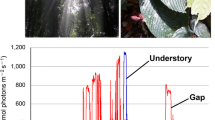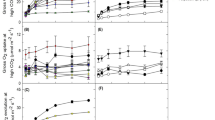Abstract
The effects of CO2 concentration and the effects of growth-light conditions on Ribulose 1,5-bisphosphate carboxylase/oxygenase (Rubisco) deactivation were examined for Spinacea oleracea (spinach). Rubisco deactivation kinetics and the degree that Rubisco activation limited the rise in photosynthesis following an increase in photon flux density (PFD) were determined from gas-exchange time courses. There were no significant differences in the apparent relaxation time for Rubisco deactivation among leaves exposed to high or low CO2 (50 or 1000 μmol mol-1) and low PFD (170 μmol m-2 s-1) or darkness. However, when PFD was increased to 1700 μmol m-2 s-1 following a period of low PFD or darkness, leaves exposed to low CO2 × low PFD showed a lower contribution to the photosynthetic induction process by the activation of Rubisco than leaves exposed to the other treatments. For the growth-light experiments, spinach was grown under high PFD × high red:far-red ratio (R:FR), low PFD × high R:FR, or low PFD × low R:FR light environments. Leaves that matured under the low PFD × low R:FR treatment showed a lower percent change in photosynthesis due to Rubisco activation than leaves exposed to the other growth-light treatments. However, there were no significant differences among the growth-light treatments in the maximum contribution of Rubisco activation to the induction response or in the apparent relaxation time for Rubisco deactivation during shade events.
Similar content being viewed by others
References
Baldocchi D and Collineau S (1994) The physical nature of solar radiation in heterogeneous canopies: Spatial and temporal attributes. In: Caldwell MM and Pearcy RW (eds) Exploitation of Environmental Heterogeneity by Plants, pp 21–72. Academic Press, San Diego, CA
Ernstsen JA, Woodrow IE and Mott KA (1997) Responses of Rubisco activation and deactivation rates to variations in growthlight conditions. Photosynth Res 52: 117–125
Hammond ET, Andrews TJ, Mott KA and Woodrow IE (1998) Regulation of Rubisco activation in antisense plants of tobacco containing reduced levels of Rubisco activase. Plant J 14: 101–110
Hoagland DR and Arnon DI (1950) The water-culture method for growing plants without soil. Univ Calif Ag Exp Sta Cir 347 (rev. ed)
Holmes MG and Smith H (1977) The function of phytochrome in the natural environment – I. Characterization of daylight for studies in photomorphogenesis and photoperiodism. Photochem Photobiol 25: 533–538
Jackson RB, Woodrow IE and Mott KA (1991) Non-steady state photosynthesis following an increase in photon flux density. Plant Physiol 95: 498–503
Kirschbaum MUF and Pearcy RW (1988) Gas exchange analysis of the relative importance of stomatal and biochemical factors in photosynthetic induction in Alocasia macrorrhiza. Plant Physiol 86: 782–785
Knapp AK and Smith WK (1990) Stomatal and photosynthetic responses to variable sunlight. Physiol Planta 78: 160–165
Kwesiga FK and Grace J (1986) The role of the red/far-red ratio in the response of tropical tree seedlings to shade. Ann Bot 57: 283–290
Mott KA (1988) Do stomata respond to CO2 concentrations other than intercellular? Plant Phys 86: 200–203
Mott KA and Woodrow IE (1993) Effects of O2 and CO2 on nonsteady-state photosynthesis. Plant Physiol 102: 859–866
Miziorko HM and Lorimer GH (1983) Ribulose 1,5-bisphosphate carboxylase/oxygenase. Ann Rev Biochem 52: 507–535
Pearcy RW (1990) Sunflecks and photosynthesis in plant canopies. Ann Rev Plant Physiol Plant Mol Biol 41: 421–453
Portis AR (1992) Regulation of ribulose 1,5-bisphosphate carboxylase/oxygenase activity. Ann Rev Plant Physiol Plant Mol Biol 43: 415–437
Roden JS and Pearcy RW (1993) Photosynthetic gas exchange response of poplars to steady-state and dynamic light environments. Oecologia 93: 208–214
Sassenrath-Cole GF and Pearcy RW(1994) Regulation of photosynthetic induction state by the magnitude and duration of low light exposure. Plant Physiol 105: 1115–1123
Seemann JR, Kirschbaum MUF, Sharkey TD and Pearcy RW(1988) Regulation of ribulose 1,5-bisphosphate carboxylase activity in Alocasia macrorrhiza in response to step changes in irradiance. Plant Physiol 88: 148–152
Smith H (1982) Light Quality, photoperception, and plant strategy. Ann Rev Plant Physiol 33: 481–518
Tinoco-Ojanguren C and Pearcy RW (1995) A comparison of light quality and quantity effects the growth and steady-state and dynamic photosynthetic characteristics of three tropical tree species. Funct Ecol 9: 222–230
Turnbull MH and Yates DJ (1993) Seasonal variation in the red/farred ratio and photon flux density in an Australian sub-tropical rainforest. Agricult Forest Meteorol 64: 111–127
Walters RG and Horton P (1995) Acclimation of Arabidopsis thaliana to the light environment: Changes in photosynthetic function. Planta 197: 306–312
Woodrow IE and Berry JA (1988) Enzymatic regulation of photosynthetic CO2 fixation in C3 plants. Ann Rev Plant Physiol Plant Mol Biol 39: 533–594
Woodrow IE and Mott KA (1989) Rate limitation of non-steadystate photosynthesis by ribulose-1,5-bisphosphate carboxylase in spinach. Aust J Plant Physiol 16: 487–500
Woodrow IE and Mott KA (1992) Biphasic activation of rubisco bisphosphate carboxylase in spinach leaves as determined from non-steady state CO2 exchange. Plant Physiol 99: 298–303
Woodrow IE, Kelly ME and Mott KA (1996) Limitation of the rate of ribulose bisphosphate carboxylase activation by carbamylation and ribulose bisphosphate carboxylase activase activity: Development and tests of a mechanistic model. Aust J Plant Physiol 23: 141–149
Author information
Authors and Affiliations
Rights and permissions
About this article
Cite this article
Ernstsen, J., Woodrow, I.E. & Mott, K.A. Effects of growth-light quantity, growth-light quality and CO2 concentration on Rubisco deactivation during low PFD or darkness. Photosynthesis Research 61, 65–75 (1999). https://doi.org/10.1023/A:1006289901858
Issue Date:
DOI: https://doi.org/10.1023/A:1006289901858




